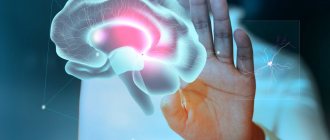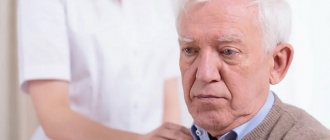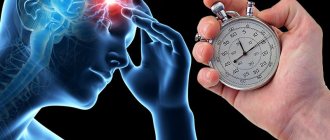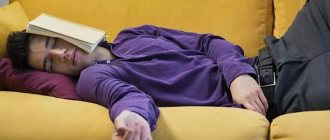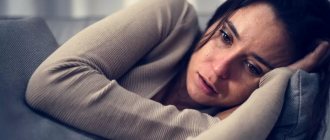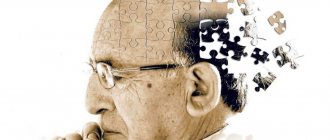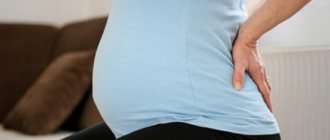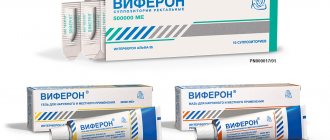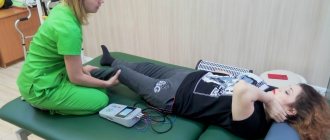Stroke, or acute cerebrovascular accident, remains one of the leading causes of death.
Practice shows that in 60% of cases the lesion is localized in the left brain structures, which control the activity of the right half of the body, where paralysis occurs. Just a few minutes of stopping blood flow is enough to kill millions of neurons and create a dead zone in the nervous tissue. The pathological process involves the pathways of CNS signals to systems and organs on the right.
Etiopathogenesis
The main mechanism for the development of paralysis is stroke - damage to the artery with blood escaping beyond the vascular bed. As a result, a hematoma is formed, which gradually grows and compresses the brain tissue. Vital neurons die, loss of function is noted, control of skeletal and smooth muscles decreases, and sensitivity disappears.
This condition is predisposed to:
- Eating disorders – the main role is played by a lack of calcium in the diet, which strengthens the walls of the arteries. In these cases, cardiologists repeat “where it’s thin, that’s where it breaks.” Weakened brain vessels that are prone to damage can cause a stroke;
- Hypertension – the situation is aggravated by increased blood pressure, which can damage weakened blood vessels. In older people, there is a lack of calcium, which can cause artery rupture;
- Compounded heredity - according to recent studies, there is a predisposition to vascular diseases, especially hypertension and strokes. The mechanism has not been fully studied; insufficiency of the neurohumoral mechanism and weakness of the vascular wall are assumed;
- Obesity - this condition is accompanied by a lack of minerals, an increase in blood pressure, which increases the likelihood of developing a stroke with subsequent paralysis;
- Cardiovascular diseases - valve malformations, heart failure, atherosclerosis and thrombosis predispose to cerebral hemorrhage;
- Endocrine diseases - diabetes comes first, leading to hypertension and hemorrhages. Sometimes the causes are hypothyroidism, pathologies of the adrenal cortex;
- Bad habits - nicotine weakens the walls of arteries and increases cholesterol levels in the blood. Natural alcohol in minimal dosages is useful, but an excess of surrogate or drunkenness often ends in stroke and paralysis.
The listed factors can provoke both left and right paralysis. According to statistics, the latter option is observed more often, which increases the patient’s chances of survival due to timely diagnosis.
Causes
The main cause of right-sided paralysis is strokes, chronic and then acute disturbances of blood supply in the structures of the left hemisphere. Nerve tissues are very sensitive to hypoxia. And even if the necrotic focus is significantly removed from the brain capsule, paralysis of the right side of the body still occurs. Most often the hand is affected.
A stroke is not a disease that happens suddenly. Its causes accumulate over years, decades, so that when a critical point is reached, one day the scenario of a “vascular catastrophe” unfolds. This leads to:
- Physical inactivity;
- Diet with a predominance of animal fats and proteins;
- Metabolism, carbohydrate and cholesterol status disorders;
- Limited or inadequate sleep;
- Abuse of tobacco, alcohol, drugs;
- Chronic or severe one-time stress.
Eliminating at least half of these causes will allow stroke to be removed from the list of major diseases that most often suffer in our time.
Types of paralysis
After a stroke, the doctor’s main task is to determine the presence of paralysis and its type. All hemorrhages on the right and left sides are divided into two categories:
- Peripheral paralysis is the most favorable variant of the disease, characterized by partial loss of function. The patient's motor neurons are damaged, which leads to loss of sensitivity and a decrease in complex and purposeful movements.
- Central paralysis - indicates hemorrhage in the motor areas, as a result of which the right arm and leg are completely amputated. Such patients are unable to care for themselves and there is a high risk of disability.
Risk factors for stroke
Stroke most often affects older people. In modern conditions, risk factors for stroke have begun to be observed in younger people, and stroke has also become “younger.” The following risk factors are known:
- arterial hypertension,
- cerebral atherosclerosis,
- diabetes,
- smoking,
- atrial fibrillation,
- tendency to form blood clots,
- hyperlipidemia.
The prospects for recovery of patients after a stroke depend on
- volume and location of the lesion,
- severity of primary neurological deficit,
- concomitant pathology
- time of commencement of rehabilitation measures.
Signs of right-sided paralysis
If there was a stroke in the left hemisphere, the patient’s right side of the body is affected, the muscles of the limbs are paralyzed and there is no speech. These are the main differences between this condition. Patients also develop the following symptoms:
- Common symptoms are headache, nausea, vomiting and weakness. They appear in the first few days and are considered the body’s response to damage to brain neurons;
- Loss of movement - with central paralysis, the right limbs are flaccid, there is no sensitivity, the patient cannot perform any actions with the right arm and leg. If peripheral neurons are affected, the patient experiences tremor, and some movements are difficult on the same side;
- Reduced memory – there are difficulties in remembering sentences; in severe cases, it is difficult for a person to repeat individual words;
- Paresis of the right facial nerve - this branch innervates all facial muscles on its side. In the absence of control, the muscles relax, the patient’s corner of the mouth and lower eyelid “hang”;
- Spontaneous contractions of some skeletal muscles on the right - usually the arm is bent at the elbow joint, the leg is straightened, and inward rotation of the foot is noted.
The listed symptoms are observed a few minutes after hemorrhage. As health deteriorates, the patient develops stress, accompanied by depression and difficulties in communication.
Forecasts
Experienced neurologists know that the consequences of a stroke cannot be predicted. It is not for nothing that this disease is translated from Latin as “insidious blow, attack.” Often the most pessimistic forecasts are refuted by the amazing plasticity of the brain, when the load of the dead area is taken on by neighboring and even distant neuron cells. The paralyzed man rises and returns to life. And vice versa: a patient who easily suffered a stroke with a positive prognosis, but returned to his previous lifestyle, receives a new stroke within a year. Already fatal.
In modern medicine, forecasts quickly become outdated, new methods and specializations appear. Yesterday's wheelchair-bound or bedridden patients have the opportunity to be restored using IT technologies, developments in biotechnology that create fundamentally new medicines, innovative tools such as exo-skeletons that teach paralyzed people to walk again. Breakthrough ideas are expected in scientific neurology, which has proven that neurogenesis (the production of new neurons even in the elderly) exists, contrary to popular belief that nerve cells do not regenerate. A method currently being tested for growing neurons from a patient's blood cells holds great promise. Neurologists will be able to repair the brain, replacing diseased areas with new ones. And this fantastic tomorrow is much closer than we can imagine.
Today, a favorable prognosis for the disease for many years depends on many factors. And the main one is the right choice of a medical institution and the choice of a doctor.
Consequences of right-sided paralysis
In severe cases, right-sided lesions lead to irreversible complications that develop as a result of massive hemorrhage or violation of treatment rules. We list the most common conditions:
- paralysis of both arms and legs;
- lifelong speech dysfunction;
- disturbance of thinking, memorization, social behavior;
- the appearance of bedsores;
- exacerbation of chronic diseases against the background of reduced physical activity;
- enuresis and fecal continence disorders.
The main task of the doctor is to create conditions that ensure full recovery after a stroke on the right side, which will minimize the development of complications.
Drug therapy
If the right side is paralyzed due to a stroke, you should start with drug therapy. The drugs of choice are:
- Antiplatelet agents and anticoagulants (Curantil, Warfarin) - thin the blood and improve its passage through the arteries. The use of these drugs is effective for atherosclerosis, thrombosis or vascular spasms;
- Diuretics (Hypothiazide, Veroshpiron) – remove excess fluid, prevent cerebral edema and hypertensive crisis;
- Antispasmodics (Papaverine, Vincamine) - relax blood vessels and improve blood circulation;
- Agnioprotectors (Parmidin, Alprostan) – have a beneficial effect on the arteries, preventing the development of spasms;
- Nootropics (Piracetam, Actovegin) - improve brain function. They are taken for a long time, including the rehabilitation period.
The doctor prescribes medications based on the patient’s condition. In severe cases, a complete list is written out, and daily blood pressure monitoring is carried out.
Complications
Neurologists have to deal with numerous complications of the physical and psychological state of a stroke, which include:
- Gross disturbances of mental, cognitive, speech activity;
- Perceptual inhibition;
- Inflammatory phenomena of the bronchopulmonary, genitourinary system due to congestion in an immobilized patient;
- Depressive states with suicidal statements.
These manifestations require the closest attention and active therapy from specialists in various fields.
Diet
Diet is necessary to improve blood circulation and maintain immune resistance. A well-chosen table should contain everything necessary for the regeneration of damaged tissues, but not overload the weakened body.
The basic rules for the diet are as follows:
- exclusion of smoked and fatty foods;
- meat can only be eaten with the approval of a doctor, in small portions and pureed. The menu includes only lean varieties;
- enrich your diet with vegetables and fruits;
- exclude coffee, strong tea, soda and alcohol;
- food should be fractional, in small portions.
For seriously ill patients, the menu is prepared by a nutritionist, taking into account the state of the body and the necessary energy costs.
Massage
This method is aimed at preventing bedsores and is used from the first days of paralysis. The right side of the body is warmed up, after which blood circulation and tissue trophism are improved, and mobility in the joints is restored.
To eliminate the effects of paralysis, a standard warm-up includes:
- stroking - from the periphery, along the blood flow;
- rubbing – carried out more intensively, similar to the previous method;
- vibration movements – in the area of soft tissues;
- The procedure ends with stroking.
To prevent new bedsores from arising, it is recommended to massage daily, regularly change the patient’s position and rub the skin with alcohol (if there are no wounds).
Fighting bedsores
Bedsores are a dangerous enemy of bedridden patients who have to remain in bed for long periods of time. Bedsores appear in areas that are subject to the greatest pressure - the tailbone, shoulder blades, buttocks, legs, forearms.
The skin here becomes thinner, and zones of necrosis form. The most effective fight against bedsores is prevention. It is important to change body position as often as possible, lay the patient on his side, keep the skin clean, carry out daily hygiene procedures, and treat problem areas with disinfectant and softening solutions.
Bedsores in advanced stages require surgical treatment. There are cases when a patient was saved in intensive care, but then, due to poor care, he died from sepsis that developed from banal bedsores. Nursing after a stroke is exactly the case when an experienced and conscientious nurse is just as important as a doctor. And sometimes it’s even more important.
Visit to a speech therapist
To restore speech, daily training is required, which will be supervised by a specialist. The patient is given homework, including systematic exercises.
The objectives of such therapy are:
- restoration of oral speech;
- rehabilitation of writing;
- normalization of speech memory.
It is very important that a person not only learns to speak, but also understands the speech of others. Experts recommend that patients not isolate themselves, but constantly contact people.
